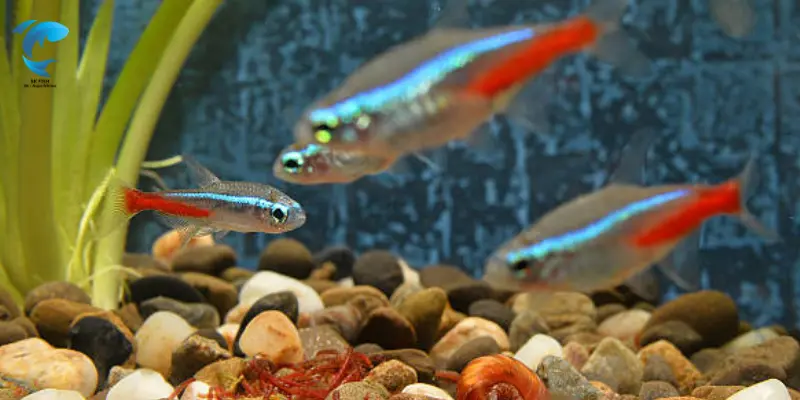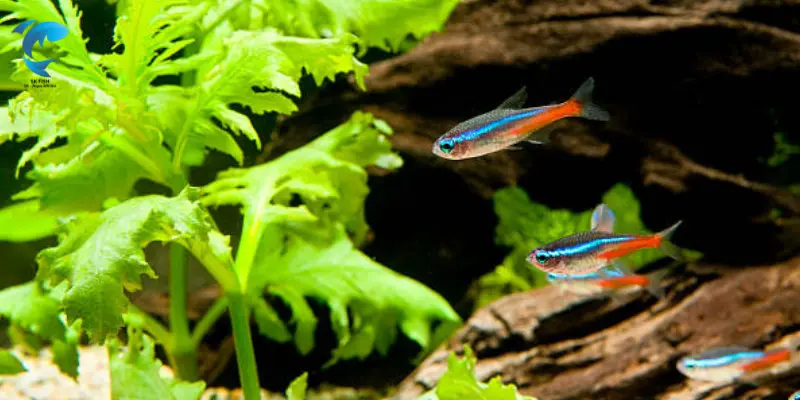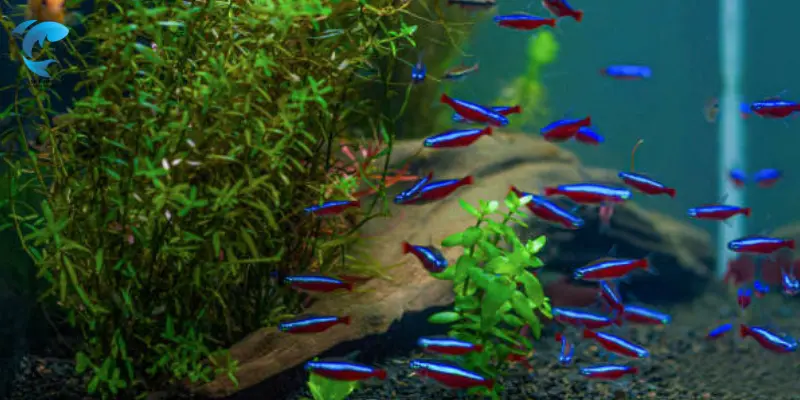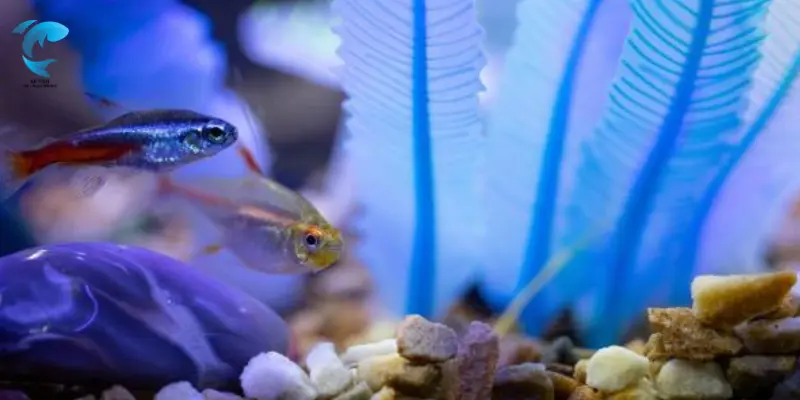Neon Tetra Fish Tank Setup: Expert Tips for 2025
Published: 8 Apr 2025
Neon Tetras are one of the most popular fish species for freshwater aquariums. Their vibrant blue and red coloring makes them a beautiful addition to any tank. Their peaceful nature and small size make them thrive in community tanks, making them a favorite among both beginners and experienced aquarium enthusiasts.
However, a proper neon tetra fish tank setup is crucial for their health and well-being. If you’re setting up a tank for your Neon Tetras, this guide will help you create the ideal environment for these lovely Fish.
In this comprehensive neon tetra aquarium setup guide, we’ll walk you through the necessary steps, from choosing the right tank size to selecting the right tank mates. We’ll also discuss their neon tetra care, feeding habits, water temperature, and much more to ensure your Neon Tetras live a long, healthy life.
Understanding Neon Tetras
Before diving into the setup, it’s essential to understand the essential characteristics of Neon Tetras.

Physical Characteristics and Behavior
Neon Tetras are small, peaceful Fish known for their striking blue and red coloration. They typically grow to about 1.5 inches (3.8 cm) in length. These Fish are active swimmers and are most comfortable in schools of at least six individuals. Neon Tetras are generally peaceful and do well in community tanks with other non-aggressive Fish.
Size, Lifespan, and Schooling Habits
Neon Tetras has lived for about 5 years and is under proper care. Due to their small size, they don’t need a large tank, but they do require enough space to swim and a school of their kind to feel secure.
Everyday Tank Mates and Compatibility
Neon Tetras are best kept with other peaceful Fish. Some ideal tank mates include:
- Corydoras catfish
- Guppies
- Otocinclus
- Other small, non-aggressive species
Avoid keeping them with larger, aggressive Fish, such as cichlids or bettas that might stress or harm them.
Tank Requirements for Neon Tetras
A successful neon tetra fish tank setup starts with the right environment. Here’s what you’ll need to provide for your Neon Tetras to thrive.
Tank Size
While Neon Tetras are small, they still need adequate space to swim and thrive. The general rule of thumb is at least 10 gallons for a small school of Neon Tetras. A larger tank offers more stability in water conditions, which is beneficial for the overall health of your Fish.
Water Conditions
Neon Tetras prefer specific water conditions to stay healthy:
- pH Level: 6.0 to 7.0 (slightly acidic to neutral)
- Water Hardness: Soft to moderately complex (2-15 dGH)
- Temperature: 70°F to 81°F (21°C to 27°C)
Water Filtration
A quality filter must keep your tank clean and your Fish healthy. Neon Tetras do best in clean, well-filtered water with minimal disturbance. A sponge or gentle power filter is ideal, as it doesn’t create too much current, which they don’t like.
Substrate and Decorations
Neon Tetras enjoy having plenty of plants and hiding spots in their environment. Opt for a fine gravel or soft sand substrate. Plants such as Java Moss, Anubias, and Amazon Swords provide hiding spots and enhance the tank’s aesthetic appeal. Decorations like caves or driftwood can also enrich the environment and reduce stress for your Fish.
Setting Up the Tank
Now that you understand the basic requirements let’s break down the step-by-step process of setting up your neon tetra fish tank.

Step-by-Step Setup
- Choosing the Right Tank: Start by selecting a tank that meets the minimum size requirements. A 10-gallon tank is perfect for a small school of Neon Tetras. Ensure the tank has a secure lid to prevent Fish from jumping out.
- Installing Filtration and Heating Systems: Install your filtration system and ensure it fits your tank size. Neon Tetras prefer low to moderate-motion water, so avoid powerful filters. A heater is also necessary to maintain a stable water temperature, especially in cooler climates.
- Adding Substrate, Plants, and Decorations: Once the filtration system is in place, add your substrate, plants, and decorations. Arrange them to create hiding spots and swimming spaces. Planting the tank makes it look natural and mimics the natural habitat of the neon tetra, which helps your fish feel more at home.
- Water Conditioning: Treat your tap water with a dechlorinator to ensure it’s safe for Fish. Fill the tank and allow the filter to run for 24–48 hours before adding Fish.
Cycling the Tank Before Adding Fish
The tank needs to be “cycled” before introducing Neon Tetras. This process establishes beneficial bacteria that break down harmful waste in the water. It typically takes 3-6 weeks to cycle the tank entirely. Test the water regularly to ensure zero ammonia and nitrite levels before adding your Fish.
Neon Tetra Care Guidelines
Proper care ensures the success of your neon tetra aquarium setup. Follow these care guidelines for a healthy and thriving tank.

Feeding Neon Tetras
Neon Tetras are omnivores and will eat a variety of foods. A balanced diet includes:
- High-quality flakes or pellets
- Live or frozen foods (like brine shrimp, daphnia, or bloodworms)
- Occasional vegetable matter, such as blanched spinach
Feed your Neon Tetras once or twice a day, providing as much food as possible in 2-3 minutes to avoid overfeeding.
Tank Maintenance
Regular maintenance is crucial for keeping the tank clean and the Fish healthy. Perform partial water changes (about 25%) every 1–2 weeks to remove excess waste and maintain water quality. Clean the filter monthly and test the water parameters regularly to ensure they are within the ideal range.
Creating an Ideal Environment

Lighting and Temperature
Neon Tetras prefer dim lighting, which simulates their natural wild habitat. Use an aquarium heater with a thermometer to maintain the tank’s temperature between 70°F and 81°F (21°C to 27°C).
Water Current
Since Neon Tetras are not strong swimmers, avoid strong currents in the tank. Ensure the filter is not creating too much water movement. This can be adjusted with a flow control valve or a sponge filter.
Neon Tetra Tank Mates
Neon Tetras are peaceful and do best in community tanks with other small, non-aggressive Fish. Avoid larger Fish that might view them as prey.
Best Tank Mates
Some good companions for Neon Tetras include:
- Corydoras Catfish
- Guppies
- Otocinclus
Fish to Avoid
- Larger predatory Fish (e.g., bettas, cichlids)
- Aggressive species that may nip at their fins
Common Mistakes to Avoid

Overcrowding the Tank
Neon Tetras need space to swim. Overcrowding leads to stress and poor water quality. Always follow the recommended stocking levels.
Improper Water Conditions
Ensure the water conditions are within the ideal range for pH, hardness, and temperature. Poor water conditions can lead to stress and disease.
Neglecting Maintenance
Regular cleaning is crucial to avoid the build-up of waste and algae. Neglecting maintenance can result in poor water quality, harming your Neon Tetras.
Troubleshooting and Problem Solving
Common Issues
- Neon Tetras not eating or hiding can be caused by stress, illness, or improper water conditions. Check water parameters and ensure tank mates are compatible.
- Signs of Illness: Look for symptoms such as faded color, odd swimming behavior, or loss of appetite. Isolate the Fish if necessary and treat the illness.
Preventing Diseases
To prevent diseases, practice good tank hygiene, quarantine new Fish before adding them to the main tank, and monitor your Fish regularly for any signs of illness.
Conclusion
Setting up the perfect neon tetra fish tank setup is key to ensuring these beautiful Fish live a long, happy life. By maintaining proper water conditions, providing a peaceful environment, and keeping up with regular maintenance, you can enjoy the vibrant beauty of Neon Tetras in your aquarium for years to come. Whether you’re a beginner or an experienced aquarium enthusiast, following these steps will help create an ideal environment for your Fish.
FAQ: Neon Tetra Fish Tank Setup
While Neon Tetras are peaceful, keeping them with Betta Fish is generally not recommended. Betta fish, particularly males, can be aggressive and territorial. They may view the small, colorful Neon Tetras as competition or prey, leading to aggression. If you must keep them together, ensure the tank is large enough to provide ample space for both species to avoid stress and conflict.
Signs of illness in Neon Tetras include faded colors, erratic swimming, clamped fins, or a loss of appetite. If you notice these symptoms, checking the water conditions (temperature, pH, ammonia levels) to rule out environmental factors is essential. You should also look for external signs like lesions, white spots (which could indicate ich), or stringy feces (which could suggest a parasite). If your Neon Tetra shows signs of illness, it’s best to isolate it in a quarantine tank and consult an aquatic vet if necessary.
Maintaining clean water is essential for the health of your Neon Tetras. To keep nitrate and ammonia levels low, you should perform regular water changes of 25-30% every 1-2 weeks. Ensure your filter runs adequately and appropriately for the tank’s size. Regularly clean the tank decorations and substrate to prevent waste build-up. Using live plants can also help improve water quality by absorbing excess nutrients.
Neon Tetras are tropical Fish and thrive in warmer water. The ideal temperature range is between 70°F and 81°F (21°C to 27°C). Keeping them in cold water below their recommended temperature range can stress them out, weaken their immune system, and make them more susceptible to diseases. If you’re keeping Neon Tetras in a tank with cooler temperatures, using an aquarium heater to maintain a stable, warm environment is essential.
Neon Tetras are schooling fish and feel safest in groups. A minimum of six Neon Tetras is recommended to reduce stress and encourage natural behaviors. A larger school (10-12 individuals) is even better, as it allows them to interact more naturally and promotes their overall well-being. A larger group also helps prevent bullying, which can occur when too few Tetras are in the tank.

SK Fish is your trusted source for practical fish care tips and delicious seafood recipes. Our team is dedicated to providing reliable, well-researched content for fishing enthusiasts and home cooks alike.

- Be Respectful
- Stay Relevant
- Stay Positive
- True Feedback
- Encourage Discussion
- Avoid Spamming
- No Fake News
- Don't Copy-Paste
- No Personal Attacks



- Be Respectful
- Stay Relevant
- Stay Positive
- True Feedback
- Encourage Discussion
- Avoid Spamming
- No Fake News
- Don't Copy-Paste
- No Personal Attacks





